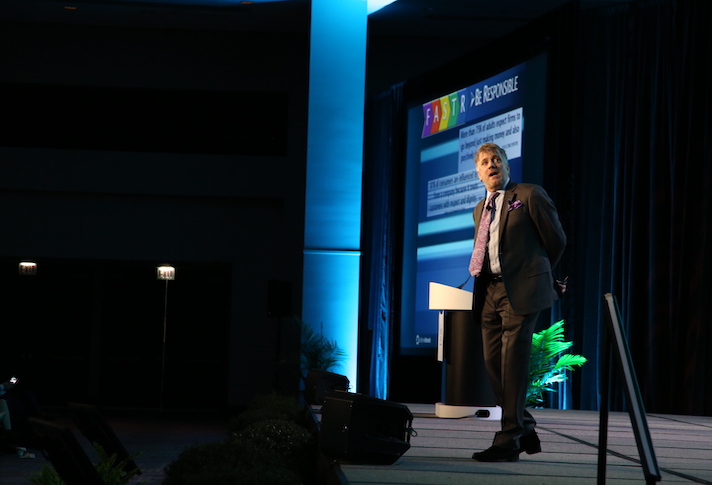IHA, Mirabile share highlights from what would have been his keynote address at The Inspired Home Show 2020
Today’s consumers have never been more diverse, demanding or complex, says Tom Mirabile, principal and founder of Springboard Futures, and consumer trend forecaster for the International Housewares Association (IHA). After The Inspired Home Show 2020 (formerly the International Home + Housewares Show) was cancelled due to concerns surrounding the spread of COVID-19, IHA spoke with Mirabile to get the consumer and lifestyle insights he would have shared in his keynote session at the Show.
Owned and operated by IHA, the Show was slated to take place March 14-17 at McCormick Place. The event typically features 2,200 exhibitors and draws 51,000 attendees from 130 countries.
A key reason today’s consumer landscape is so complex? We have four distinctly different generations with totally different desires and expectations making significant impacts.
“Many people have embedded perceptions of different generations,” says Mirabile. “We tend to anchor economic power in terms of money, but a lot of that has really changed. There’s affluence, and then there’s influence. In truth, influence is likely the greater strength because it can spread so quickly across economic and social strata and affect consumer opinion and spending.”
Take for instance Generation Z – generally described as those 8-21 years old. Certainly, that generation doesn’t have a lot of buying power, but 93% of parents with Gen Z kids say those kids influence what they buy at home, according to digital agency Deep Focus.
“Now that doesn’t mean you should market to kids, but you should acknowledge that kids are part of the decision-making process,” says Mirabile.
Boomers too are changing their habits. “Boomers are really moving toward purchasing experiences, rather than objects,” he said. “To get them to buy an object, it either has to have strong points of differentiation from what they already own….such as making a household task easier or faster, or take it off of their hands completely – like the robotic vacuums so popular now. That product is delivering three things: a cleaner floor, reduced physical strain, and time. Boomers—all of us — want more than function, we want intangible benefits as well.”
Generation X is largely overlooked right now, he adds. But that generation currently represents 29% of all discretionary income…a number poised to grow significantly in the next decade as their wages grow and they stand to inherit money from parents.
The Millennial generation has already established its influence over everything from e-commerce and marketing to social responsibility and transparency. Now they’re also starting to exhibit the financial clout we knew they’d have one day.
A few more generational realities Mirabile points out:
Generation Z actually prefers in-store shopping to online shopping, thanks in part to new experiential elements retailers have recently added…that’s more of what they’ve grown up with. Yes, Millennials are in debt, $42,000 on average, according to Northwestern Mutual’s Planning and Progress study. But only 16% of that debt is from education. They’ve largely spent on travel and lifestyle, feeding their diverse interests and hunger for experience. The youngest Boomers will be at the age of retirement in just 10 years; think of the sheer number of people with “senior citizen” status and what their needs might be. All this understood, Mirabile acknowledges that generational diversity has gotten so complex that it’s easy to get distracted or lost in all the numbers and opinions.
“Statistics can deliver important insight, no question,” he says. “Still, the best strategies are rooted in a commitment to stay tethered to one or more fundamental consumer realities and aspirations. It’s crucial to keep these universal trends in mind, because while intangible, they consistently drive consumer demand, regardless of generation or socio-economic status.
He reminds us that tomorrow and 20 years from tomorrow, a majority of consumers will still want:
- More Time
- More Space
- More Experiences
- More Health and Wellness
- More Safety and Security
- More Convenience
- More Flexibility/Versatility
- More Reliability/Durabilty
- More Sustainability
As for the effects of the COVID-19 pandemic:
“I think we’re really going to see who’s got good lemonade recipes,” says Mirabile, alluding to the proverbial advice of turning lemons into lemonade. “And for those who really watch and listen to consumers, there are going to be some incredible new opportunities.”
Mirabile predicts the pandemic will propel the already-developing virtual office trend and consumers’ ability to work from home, as well as the enhanced need for products that help us monitor and care for our health from home. Any home products that help enhance consumers’ feelings of comfort and security should also fare well.
“Home has assumed many identities over the past few decades; it has been a showplace and a social hub, a cocoon and a creative studio,” he says. “It’s played the role of office space and marketplace. It’s lived through ‘own your own,’ ‘grow your own,’ ‘make your own’ and ‘sell your own.’ Next up: Home as Family Fortress.”
Mirabile’s complete presentation is available on the homepage at TheInspiredHomeShow.com For more information about the Show itself, visit TheInspiredHomeShow.com. To learn about new products that were to be at the Show, visit Housewares.org/housewaresconnect365 and select “Featured New Products for Media & Buyers.”

